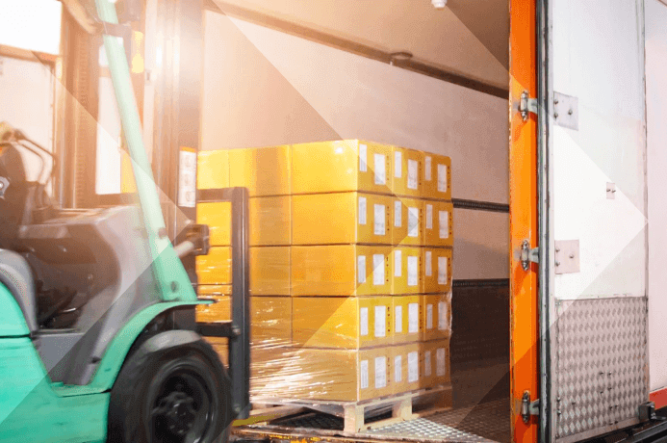A Shipper’s Guide to Consolidated Freight

In business, one of the best ways to control costs is to improve the efficiency of your operations. With continuing volatility in the supply chain, finding efficiencies in your shipping to reduce costs is essential to profitability.
One option many shippers are using is consolidated freight shipping. While any sized business can use consolidated shipping, it’s especially beneficial for companies with smaller shipments or only a few pallets to move.
What is consolidated freight shipping?
Consolidated freight shipping combines multiple less than truckload (LTL) shipments into a full container shipment. Shippers only pay for the space they use as part of the consolidated cargo, so consolidated shipping allows shippers to share the truckload cost, making it more cost-efficient than LTL rates.
Consolidated freight can contain multiple LTL shipments from one company or use consolidators to combine LTL shipments from multiple companies.
Once shipments arrive at distribution centers, they’re broken down into individual LTL shipments and loaded onto trucks for last-mile delivery.
LCL vs. LTL vs. FTL shipping
There are several ways to ship freight, including consolidated shipments. You can share containers or trucks to reduce costs. The freight class, the volume of goods you have to ship, and the delivery dates will play a significant role in choosing LCL, LTL, or FTL.
Less than container (LCL): When freight is too small to require a full container, it can be expensive to ship on its own. Instead, you can combine freight with other goods and consolidate them to make up full containers. When consolidated, shipments are priced based on volume.
Less than truckload (LTL): LTL shipments do not fill up an entire truck. Trucking companies will combine multiple LTL shipments, typically from different companies, to maximize loads.
Full truckload (FTL): FTLs are what the name implies. Shippers get the exclusive use of an entire truck, and your freight is not combined with anyone else’s cargo.
The benefits of consolidated shipping
The are several significant benefits of consolidated shipping. The most important is the ability to more tightly control and reduce your shipping costs by better utilizing truck space.
Reduced costs
Depending on your requirements, you might use only part of a trailer but pay for the entire space. One of the biggest benefits of consolidated shipping is sharing truck costs with other shippers. A consolidation service can combine multiple shipments headed to the same location into a full truckload, but you only pay for the space your cargo takes up.
Because shipping costs less with consolidated freight, your customers can make smaller, more frequent purchases without worrying about high shipping fees. Consolidated shipping can save you money when you don’t ship large freight volumes, but it can also increase your order frequencies and help your cash flow.
Lower risk
The more your freight is touched, the more opportunities for damage. LTL, for example, has multiple touchpoints for cargo, using a hub-and-spoke distribution. It might include multiple stops and rearranging cargo. When you consolidate freight, it moves from you to a consolidation center for delivery. This reduces handling and the potential for damage.

Greater quality control
Consolidating freight allows you to conduct quality control when the product reaches the warehouse. If there’s a problem with your shipment, you can deal with it then rather than wait until it arrives at its final destination. Sending replacement products via consolidated freight also gets them to their destination less expensively than LTL.
Higher customer satisfaction
When you consolidate freight, you can avoid the higher costs of other shipping methods. This allows you to pass along some of the savings to your customers. It can also make your customers’ lives easier. If cargo in a consolidated freight shipment is headed to the same customer, they only have to unload one container rather than several from different trucks.
Improved relationships
When using consolidated freight, you can build relationships with consolidators, other suppliers, and shippers. Companies using LTL shipping on the same routes can become partners, so you both save on freight costs.
Building relationships with consolidators and carriers will also improve your chances of getting high-quality service.
Increased consistency
Consistency is key in maintaining good relationships with your customers. You can damage that relationship if you can’t consistently deliver shipments to your customers on time or keep up with demand.
Freight consolidation provides consistency by moving cargo quickly and efficiently. Many shippers send inventory to consolidation centers in advance. They can ship out earlier from the center when those orders come in versus waiting for your company to ship. This means you can fulfill orders faster and stay ahead of demand.
Greater sustainability
An often overlooked but significant benefit of consolidated shipping is fewer trucks on the road. This helps your business reduce its carbon footprint and promotes sustainability.
The challenges of consolidated shipping
Finding quality carriers
Not all carriers are open to handling consolidated shipments because of the additional layer of complexity involved. For example, it can be more time-consuming to ensure accurate billing.
You need to choose quality carriers that will get the job done right. The Trucksop.com Load Board for Shippers can help you find the best carriers by providing ratings, inspections data, history, complaints, and compliments.
Planning and organization
Freight consolidation does require additional organization and planning versus full container shipping or full truckloads. You need to pair your shipments with other goods or combine orders with other companies and pay attention to dimensions, timelines, and pricing to ensure efficient and cost-effective delivery.
You may need to work with consolidators to handle this and coordinate shipments to ensure on-time delivery.
Time commitment
When you consolidate freight, there is an additional step in the mix. It takes extra time to consolidate the freight upfront and break it down at distribution centers. It’s essential to build this time into your delivery schedules.
Any time you can save along the way can help you work more efficiently, get your goods to their destination faster, and get paid sooner. One way to speed up your process is by onboarding quality carriers automatically. With Truckstop RMIS Carrier Onboarding, you get automated access to more than 98% of all active carriers in the U.S. and Canada, plus continuous carrier monitoring.

Is consolidated freight shipping right for your business?
Consolidated freight shipping could be a viable alternative if you use LTL shipping regularly. By sharing space with other shippers, you can lower your shipping costs. Consolidated shipping is also good for companies that send a lot of smaller loads.
When you choose the right carriers to handle your consolidated freight, you’re also building shipping partnerships that can improve your supply chain and save money along the way.
Find quality carriers and consolidate your loads.
What is consolidated shipping? It’s a way to combine shipments to save money and ship smaller loads without the higher costs of LTL freight.
With Truckstop Load Board for Shippers, you can find high-quality carriers, whether you’re moving a single load or looking to build a long-term relationship with carriers. Get started today.
Get helpful content delivered to your inbox.
Sign up today.
Find high-quality loads fast, get higher rates on every haul, and access tools that make your job easier at every turn.







